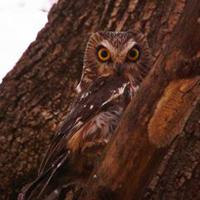Raptor watching ethics
We are all excited when we get the chance to see raptors in the wild, especially when they are performing natural behaviors such as hunting or raising young.
However, we should all be aware that our behavior can have a negative impact on their lives. Following the guidelines listed below will minimize the effects of our presence and still allow us to revel in the beauty of raptors. The information listed below pertains not only to young raptors, but all wild animals.
- View raptors from a safe distance for both you and them. If the birds alter their behavior you are too close!
- Respect that raptors develop daily routines. Remember that if you are in a public place, others may also be observing the birds and the impact is cumulative. Consider that you may be the 50th person to stop at the site and raptor parents may not appropriately tend to their young. If you feel the desire to take photographs, keep in mind that the welfare of the raptors and habitat are irrefutably more important than your photograph. Use appropriate lenses to stay a respectable distance.
- Never crowd, pursue, prevent escape, make deliberate noises to distract, startle or otherwise harass raptors. When young, raptors may be more tolerant of close proximity to people until they have developed the appropriate fear response. Learning potential threats to its safety is critical for a young raptor’s survival. Adult birds can be spooked and take off quickly without first assessing their surroundings. This can lead to collisions with obstacles in their path.
- Never feed or leave food for young raptors. The basis of the parental bond is the delivery of food. If you sever that bond, young raptors won’t call for and interact properly with their parents. They will miss out on learning skills they need to survive.
- Stay on roads, trails, and paths where they exist. Keep habitat disturbance to a minimum and acquaint yourself with the fragility of the ecosystem.
Resources:
- Lori Arent, Clinic Manager, The Raptor Center
- North American Nature Photography Association Principles of Ethical Field Practices: http://www.nanpa.org/committees/ethics/
- Audubon Pacific Flyway Audublog Bird Photography Code of Ethics: http://www.audublog.org/?p=8351
- Another great resource is Audubon's Ethical Bird Photography
